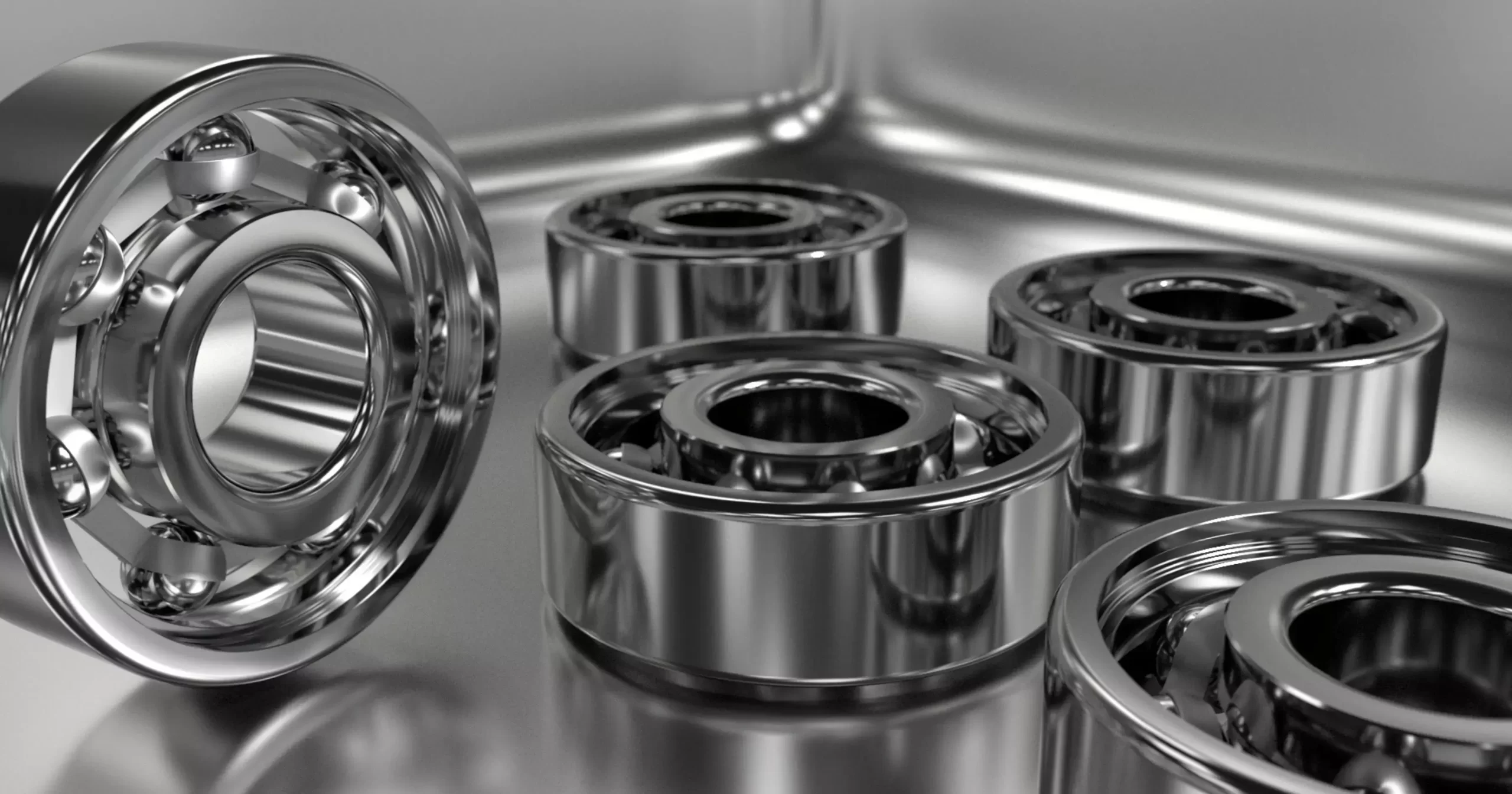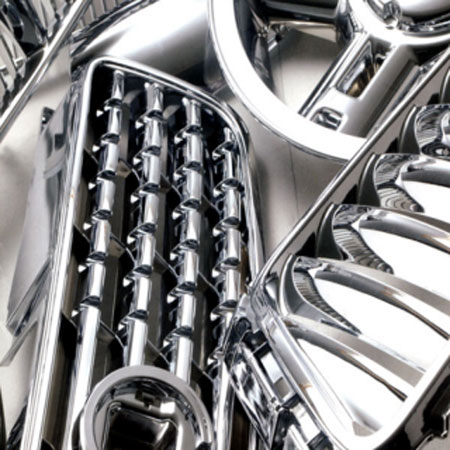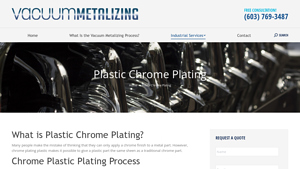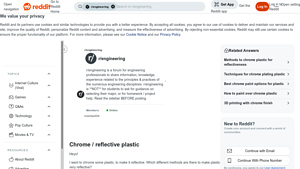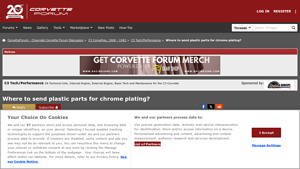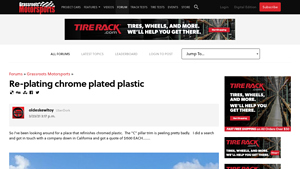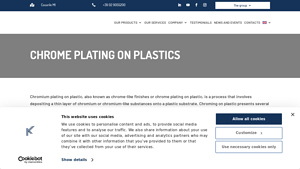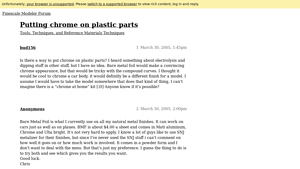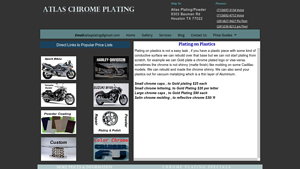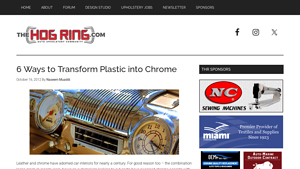Chrome Plating On Plastic Parts Guide: Type, Cost, Top List…
Introduction: Navigating the Global Market for chrome plating on plastic parts
In the competitive landscape of manufacturing and automotive industries, sourcing chrome plating for plastic parts presents a unique challenge for B2B buyers. The need for high-quality aesthetics, durability, and cost-effectiveness drives companies to seek reliable solutions that enhance the visual appeal of plastic components without compromising performance. This comprehensive guide on chrome plating on plastic parts addresses the complexities of this process, covering various methods such as traditional chrome plating, vacuum metalizing, and innovative alternatives like spray chrome and chrome film.
International buyers, particularly from Africa, South America, the Middle East, and Europe (including key markets like Germany and Brazil), will find actionable insights on the types of chrome plating available, their respective applications, and critical factors to consider when vetting suppliers. The guide also delves into cost implications and best practices for ensuring quality and efficiency in sourcing these services.
By empowering B2B buyers with the knowledge to navigate the global market for chrome plating, this guide aims to facilitate informed purchasing decisions that align with both aesthetic and functional requirements. Whether you are enhancing automotive interiors or producing consumer goods, understanding the nuances of chrome plating on plastic parts can significantly impact your product’s marketability and longevity.
Understanding chrome plating on plastic parts Types and Variations
| Type Name | Key Distinguishing Features | Primary B2B Applications | Brief Pros & Cons for Buyers |
|---|---|---|---|
| Plastic Chrome Plating | Involves a multi-step process including etching, neutralization, and electroplating | Automotive, consumer goods, electronics | Pros: High-quality finish, durability, UV protection. Cons: More expensive, longer lead times, not suitable for flexible plastics. |
| Vacuum Metalizing | Uses a vapor deposition technique to apply a thin layer of aluminum | Automotive reflectors, decorative items | Pros: Excellent aesthetic appeal, lightweight. Cons: Limited to rigid plastics, can be costly for small runs. |
| Chrome Spray Paint | A DIY-friendly option that mimics chrome using aerosol paint | Small-scale projects, custom modifications | Pros: Cost-effective, quick application. Cons: Less durable, finish may resemble silver more than chrome, requires careful application. |
| Chrome Film | Adhesive-backed films that can be applied to surfaces | Vehicle interiors, promotional items | Pros: Easy to apply, versatile for various shapes. Cons: Susceptible to tears and scratches, may not provide the same premium feel as true chrome. |
| Spray Chrome | A spray-on solution that achieves a chrome-like finish | Automotive, custom parts, restoration projects | Pros: Quick application, high-quality finish, available in various colors. Cons: Not as durable as traditional plating, requires proper technique for best results. |
What Are the Characteristics of Plastic Chrome Plating?
Plastic chrome plating is a sophisticated process that enhances the aesthetic and functional properties of rigid plastic components. This method involves multiple steps, including etching, neutralization, and electroplating, which together create a durable and conductive surface suitable for chrome application. It is ideal for industries such as automotive and consumer goods, where a premium finish is essential. B2B buyers should consider the higher costs and longer lead times associated with this method, along with its limitations on flexible plastics.
How Does Vacuum Metalizing Differ from Other Methods?
Vacuum metalizing is characterized by its unique vapor deposition technique, which involves applying a thin layer of aluminum to a plastic substrate. This method is widely used in automotive reflectors and decorative items due to its excellent aesthetic appeal and lightweight properties. However, it is primarily suited for rigid plastics and may not be the most economical choice for smaller production runs. B2B buyers should weigh the benefits of visual appeal against the potential costs and production limitations.
What Are the Benefits of Using Chrome Spray Paint?
Chrome spray paint offers a cost-effective and quick solution for achieving a chrome-like finish on plastic parts. This DIY-friendly option is particularly suitable for small-scale projects or custom modifications. However, its durability is a significant drawback; the finish may not withstand harsh conditions and can resemble silver more than true chrome. For B2B buyers, the ease of application and affordability make it an attractive choice, but they should be prepared for potential quality compromises.
Why Choose Chrome Film for Plastic Parts?
Chrome film is an adhesive-backed option that can be easily applied to various surfaces, making it a versatile choice for vehicle interiors and promotional items. It allows for creative customization, especially on curved surfaces. However, its susceptibility to tears and scratches means that it may not provide the same premium feel as traditional chrome plating. B2B buyers should consider the application context and the potential need for replacement when evaluating this option.
What Makes Spray Chrome a Viable Alternative?
Spray chrome is a versatile solution that allows for the application of a chrome-like finish directly onto plastic parts. It provides a high-quality finish comparable to traditional chrome plating while allowing for on-site application. This method is particularly beneficial for automotive and restoration projects where time and quality are critical. While it offers a range of colors and finishes, buyers should be aware that it may not match the durability of conventional plating methods, necessitating proper technique for optimal results.
Key Industrial Applications of chrome plating on plastic parts
| Industry/Sector | Specific Application of chrome plating on plastic parts | Value/Benefit for the Business | Key Sourcing Considerations for this Application |
|---|---|---|---|
| Automotive | Interior trim and dashboard components | Enhances aesthetic appeal and perceived luxury | Ensure compatibility with specific plastic types; assess local plating facilities for quality assurance. |
| Electronics | Housing for consumer electronics | Provides UV protection and enhances durability | Evaluate suppliers for certifications and production capacity; consider lead times for international shipping. |
| Consumer Goods | Decorative elements for appliances | Improves marketability and product differentiation | Investigate sourcing options for low-volume runs; consider environmental compliance in plating processes. |
| Aerospace | Lightweight components in cabin interiors | Reduces weight while maintaining a premium finish | Assess the ability to meet strict aerospace standards; prioritize suppliers with experience in high-performance applications. |
| Home Decor | Fixtures and fittings for furniture | Adds a modern, high-end look to products | Look for suppliers with custom solutions; verify quality control processes to ensure consistent finishes. |
How is Chrome Plating on Plastic Parts Used in the Automotive Industry?
In the automotive sector, chrome plating on plastic parts is extensively used for interior trim and dashboard components. This process transforms standard plastic into visually appealing chrome-like surfaces, enhancing the overall aesthetic of vehicles. By utilizing chrome plating, manufacturers can deliver a luxurious feel at a lower cost compared to traditional chrome components. Buyers should consider the compatibility of the plastic types used in their vehicles and assess local plating facilities to ensure quality and efficiency.
What are the Benefits of Chrome Plating for Electronics Housing?
In the electronics industry, chrome plating is applied to housings for consumer electronics, such as mobile devices and home appliances. This application not only provides an attractive finish but also offers protection against ultraviolet (UV) radiation and environmental wear. The durability gained through chrome plating can extend the lifespan of products, which is a significant selling point. International buyers should evaluate suppliers based on certifications and production capacity, ensuring that they meet quality standards while considering lead times for shipping.
How Does Chrome Plating Enhance Consumer Goods?
For consumer goods, decorative elements like knobs and handles are often chrome-plated to improve marketability and differentiate products in a competitive landscape. The shiny finish attracts consumers and implies higher quality, which can justify a premium price point. Buyers in this sector should investigate sourcing options for low-volume production runs and consider environmental compliance in plating processes to align with global sustainability trends.
Why is Chrome Plating Important in Aerospace Applications?
In the aerospace industry, chrome plating is applied to lightweight components found in cabin interiors. This application reduces weight while providing a premium finish, which is essential for both performance and aesthetics in aircraft. Buyers must prioritize suppliers that can meet strict aerospace standards and have experience in high-performance applications to ensure safety and durability in their products.
How Can Chrome Plating Transform Home Decor Products?
In the home decor sector, chrome plating is utilized for fixtures and fittings, such as lamp bases and furniture hardware. The application provides a modern, high-end look that appeals to consumers seeking stylish interiors. Buyers should look for suppliers that offer custom solutions tailored to specific design needs and verify quality control processes to ensure that the chrome finish is consistent and durable over time.
3 Common User Pain Points for ‘chrome plating on plastic parts’ & Their Solutions
Scenario 1: The Challenge of Inconsistent Quality in Chrome Plating
The Problem: B2B buyers often face the issue of inconsistent quality when sourcing chrome plating services for plastic parts. This inconsistency can arise from various factors, including the chosen vendor’s expertise, the plating process used, or the type of plastic involved. For instance, a buyer may receive parts that have uneven chrome finishes, leading to aesthetic discrepancies that can negatively impact the overall product quality. This not only jeopardizes customer satisfaction but can also result in costly rework or replacement.
The Solution: To mitigate the risk of inconsistent quality, buyers should prioritize thorough vendor evaluations before committing to any service. This includes requesting samples of previous work, checking references, and assessing the vendor’s quality control processes. Additionally, specifying the exact requirements for the chrome finish—such as thickness, gloss level, and durability—can help ensure that the vendor adheres to the desired standards. Establishing a clear communication channel throughout the plating process is also crucial. Regular updates and quality checks can help catch any issues early, allowing for timely adjustments before the final delivery.
Scenario 2: The Cost Implications of Traditional Chrome Plating
The Problem: Another common pain point for B2B buyers is the high cost associated with traditional chrome plating on plastic parts. Many manufacturers may underestimate the expenses involved, which can lead to budget overruns and financial strain, especially for larger production runs. The labor-intensive nature of the process, along with material costs and potential shipping fees, can significantly inflate the overall budget.
The Solution: To address cost concerns, buyers should explore alternative methods of chrome plating that offer more competitive pricing without sacrificing quality. Options such as vacuum metalizing or spray chrome can provide similar visual effects at a fraction of the cost. Buyers should conduct a cost-benefit analysis to determine which method aligns best with their budget and production needs. Furthermore, negotiating bulk pricing with vendors or considering local plating services can reduce shipping costs and time delays. Establishing long-term relationships with reliable suppliers may also lead to better pricing structures.
Scenario 3: Compatibility Issues with Various Plastic Types
The Problem: Compatibility issues between the chrome plating process and different types of plastics can pose significant challenges for B2B buyers. Not all plastics can withstand the plating process, particularly flexible materials, which may warp or break during treatment. This limitation can lead to the rejection of parts, wasted materials, and delays in production schedules, impacting project timelines and profitability.
The Solution: To overcome compatibility issues, it is essential for buyers to conduct thorough assessments of the plastics they intend to plate. Understanding the properties of each plastic type, including rigidity and thermal tolerance, can help in selecting suitable materials for chrome plating. Collaborating closely with plating vendors to conduct preliminary tests on a small batch of parts can also yield valuable insights into how well a particular plastic will perform during the plating process. Additionally, buyers should maintain an open dialogue with their vendors about any concerns related to material compatibility, which can facilitate better planning and minimize the risk of production setbacks.
Strategic Material Selection Guide for chrome plating on plastic parts
What are the Key Properties of Common Materials Used for Chrome Plating on Plastic Parts?
When selecting materials for chrome plating on plastic parts, it is essential to consider their properties, manufacturing complexities, and the specific needs of international buyers. Below, we analyze four common materials used in this process: ABS (Acrylonitrile Butadiene Styrene), PC (Polycarbonate), PVC (Polyvinyl Chloride), and PBT (Polybutylene Terephthalate).
How Does ABS Perform in Chrome Plating Applications?
Key Properties: ABS is known for its excellent impact resistance and mechanical strength. It can withstand temperatures up to 80°C (176°F) and offers good chemical resistance.
Pros & Cons: The advantages of ABS include its affordability and ease of processing, making it a popular choice for automotive and consumer products. However, ABS is less resistant to UV light, which can lead to discoloration over time. This can be a significant drawback for applications exposed to sunlight.
Impact on Application: ABS is compatible with various media, making it suitable for automotive interiors and electronic housings. However, its UV sensitivity necessitates protective coatings or treatments to enhance longevity.
Considerations for International Buyers: Compliance with standards such as ASTM D3965 for impact resistance is crucial. Buyers from regions like Europe may prefer materials that meet REACH regulations, while those in South America might focus on cost-effectiveness.
What Makes Polycarbonate a Suitable Choice for Chrome Plating?
Key Properties: Polycarbonate is characterized by its high impact resistance and transparency, with a temperature tolerance of up to 120°C (248°F). It also has excellent dimensional stability.
Pros & Cons: The main advantage of polycarbonate is its strength and durability, making it ideal for safety applications. However, it is more expensive than ABS and can be prone to scratching without proper coatings.
Impact on Application: Polycarbonate’s ability to withstand high temperatures makes it suitable for automotive and electronic applications. However, its scratch sensitivity can affect the aesthetic quality of chrome finishes.
Considerations for International Buyers: Buyers should be aware of international standards like ISO 7391 for optical properties. In regions like the Middle East, where high temperatures are common, polycarbonate’s thermal stability is a significant advantage.
How Does PVC Compare in Chrome Plating Applications?
Key Properties: PVC is known for its chemical resistance and versatility, with a temperature rating of up to 60°C (140°F). It is also lightweight and has good electrical insulation properties.
Pros & Cons: The cost-effectiveness of PVC makes it an attractive option for various applications. However, its lower temperature tolerance and rigidity can limit its use in high-performance environments.
Impact on Application: PVC is commonly used in plumbing and electrical applications due to its chemical resistance. However, its rigidity may not be suitable for parts requiring flexibility.
Considerations for International Buyers: Compliance with ASTM D1784 for PVC materials is essential. Buyers in Africa may prioritize cost, while those in Europe may focus on environmental regulations regarding PVC use.
What Advantages Does PBT Offer for Chrome Plating?
Key Properties: PBT is known for its excellent thermal and chemical resistance, with a temperature rating of up to 140°C (284°F). It also has good dimensional stability and low moisture absorption.
Pros & Cons: PBT’s resistance to heat and chemicals makes it suitable for automotive applications. However, it can be more expensive than other plastics and may require specialized processing techniques.
Impact on Application: PBT is ideal for automotive components and electrical housings due to its durability. However, the higher cost may limit its use in budget-sensitive projects.
Considerations for International Buyers: Understanding compliance with standards such as DIN EN ISO 1043 for plastics is vital. Buyers from regions like Brazil may focus on the cost-benefit ratio, while those in Europe may prioritize sustainability.
Summary Table of Material Selection for Chrome Plating
| Material | Typical Use Case for chrome plating on plastic parts | Key Advantage | Key Disadvantage/Limitation | Relative Cost (Low/Med/High) |
|---|---|---|---|---|
| ABS | Automotive interiors, consumer products | Affordable and easy to process | UV sensitivity can lead to discoloration | Low |
| PC | Safety applications, automotive parts | High impact resistance and durability | More expensive and prone to scratching | High |
| PVC | Plumbing, electrical applications | Cost-effective and chemically resistant | Lower temperature tolerance and rigidity | Low |
| PBT | Automotive components, electrical housings | Excellent thermal and chemical resistance | Higher cost and specialized processing required | Med |
This strategic material selection guide provides valuable insights for B2B buyers looking to optimize their chrome plating processes on plastic parts, ensuring they make informed decisions tailored to their specific regional requirements and product applications.
In-depth Look: Manufacturing Processes and Quality Assurance for chrome plating on plastic parts
What Are the Key Stages of the Chrome Plating Process for Plastic Parts?
Chrome plating on plastic parts involves a series of meticulously planned stages to ensure high-quality results. The process typically consists of material preparation, forming, assembly, and finishing.
Material Preparation
The first step involves preparing the plastic components. This includes thorough cleaning to remove any contaminants that might interfere with the plating process. Depending on the type of plastic, an etching process may be necessary. This typically involves immersing the parts in a mixture of acids to create microscopic surface textures that enhance the adhesion of the metal coatings.
Forming
Once the parts are prepared, they are formed into their desired shapes. This step is crucial as it determines the final dimensions and overall aesthetics of the plastic parts. Rigid plastics are preferred for chrome plating due to their ability to withstand the stresses of the process. Flexible plastics may deform or crack, making them unsuitable.
Assembly
After forming, components may be assembled if the final product consists of multiple parts. This assembly must be done with precision to ensure that all parts align correctly before the plating process begins. Any misalignment can lead to defects in the chrome finish.
Finishing
The final stage is the actual chrome plating process. This involves several sub-steps, including applying a base layer (usually nickel or copper) through electro-less plating, followed by the actual chrome application via electroplating. This method ensures that the chrome finish is even and adheres well to the plastic surface.
What Techniques Are Utilized in Chrome Plating on Plastic Parts?
Several techniques are employed during the chrome plating process, each designed to enhance the quality and durability of the finish.
Electro-less Plating
This technique applies a conductive layer to the plastic without using electrical current. A nickel or copper layer is deposited, which prepares the surface for the chrome finish. This step is essential as it allows the chrome ions to bond effectively.
Electroplating
In this method, the pre-treated plastic part is immersed in a solution containing positively charged chrome ions. When a negative charge is applied, the ions are attracted to the part, resulting in a uniform chrome layer. This technique is vital for achieving a high-gloss finish.
Vacuum Metalizing
An alternative to traditional plating, vacuum metalizing involves vaporizing metal (usually aluminum) in a vacuum chamber and allowing it to condense on the plastic surface. This method can produce a shiny finish similar to chrome but may not offer the same durability.
How Is Quality Assurance Implemented in Chrome Plating Processes?
Quality assurance is critical in the chrome plating process, particularly for B2B buyers who require consistent and high-quality results.
International and Industry Standards
Manufacturers often adhere to international standards such as ISO 9001, which outlines criteria for quality management systems. This standard ensures that companies maintain consistent quality in their processes and products. Additionally, industry-specific standards like CE and API may apply depending on the sector, such as automotive or aerospace.
Quality Control Checkpoints
Quality control is typically structured around various checkpoints throughout the manufacturing process:
-
Incoming Quality Control (IQC): This step involves inspecting raw materials upon arrival to ensure they meet specified standards.
-
In-Process Quality Control (IPQC): During the manufacturing stages, periodic checks are performed to identify any issues early in the process. This can involve visual inspections and dimensional checks.
-
Final Quality Control (FQC): After the chrome plating is completed, a thorough inspection is conducted. This includes assessing the evenness of the chrome coating, checking for defects, and ensuring compliance with specifications.
What Testing Methods Are Commonly Used in Quality Assurance for Chrome Plating?
Various testing methods are employed to ensure the quality of chrome-plated plastic parts.
Adhesion Testing
This test assesses how well the chrome adheres to the plastic surface. Techniques such as the tape test are commonly used, where adhesive tape is applied and then removed to check for any peeling.
Thickness Measurement
Using tools like micrometers or ultrasonic thickness gauges, manufacturers measure the thickness of the chrome layer. This ensures that the coating meets the specified requirements for durability and appearance.
Visual Inspections
Visual checks are performed throughout the process to identify any aesthetic defects. This includes looking for blemishes, uneven coatings, or color discrepancies.
How Can B2B Buyers Verify Supplier Quality Control Processes?
B2B buyers, especially those from diverse regions such as Africa, South America, the Middle East, and Europe, should take several steps to verify the quality control processes of their suppliers.
Supplier Audits
Conducting on-site audits allows buyers to assess the supplier’s manufacturing processes and quality assurance systems firsthand. This can help identify any potential issues before placing large orders.
Quality Assurance Reports
Requesting detailed quality assurance reports from suppliers can provide insights into their testing methods, compliance with standards, and overall product quality. These reports should outline the results of various tests and inspections.
Third-Party Inspections
Engaging third-party inspection services can offer an unbiased assessment of the supplier’s quality control processes. These organizations can conduct independent audits and testing to ensure compliance with international standards.
What Are the Quality Control Considerations for International B2B Buyers?
When dealing with international suppliers, B2B buyers must consider additional factors that could impact quality control.
Regulatory Compliance
Different regions may have varying regulatory requirements, which can affect the manufacturing and quality assurance processes. Buyers should ensure that suppliers are compliant with local regulations in their target markets.
Cultural and Language Differences
Cultural nuances and language barriers may lead to misunderstandings regarding quality expectations. Establishing clear communication channels and documentation can help mitigate these challenges.
Logistical Challenges
Shipping and handling can introduce additional risks to product quality. Buyers should discuss packaging and transportation methods with suppliers to ensure that products arrive in optimal condition.
By understanding these manufacturing processes and quality assurance measures, B2B buyers can make informed decisions when sourcing chrome-plated plastic parts, ultimately ensuring they receive high-quality products that meet their specifications.
Practical Sourcing Guide: A Step-by-Step Checklist for ‘chrome plating on plastic parts’
Introduction
This practical sourcing guide provides a step-by-step checklist for B2B buyers looking to procure chrome plating services for plastic parts. Chrome plating enhances the aesthetic appeal and durability of plastic components, making them suitable for various applications, especially in automotive and consumer goods. Following this guide will ensure that you choose the right supplier and achieve the best results for your projects.
Step 1: Define Your Technical Specifications
Clearly outline the technical requirements for your chrome-plated plastic parts. Consider factors such as the type of plastic, dimensions, weight, and the specific finish you desire. Defining these specifications upfront helps suppliers understand your needs and allows for accurate quotations.
- Key considerations:
- Rigid vs. flexible plastics: Only rigid plastics can typically withstand the chrome plating process.
- Desired finish quality: Determine if you need a high-gloss finish or a more matte look.
Step 2: Research Chrome Plating Methods
Familiarize yourself with the various chrome plating methods available for plastic parts. Options include traditional chrome plating, vacuum metalizing, and spray chrome techniques. Understanding these methods will help you assess which process aligns best with your project goals.
- Important factors:
- Cost and time: Traditional methods may be more expensive and time-consuming compared to spray chrome options.
- Aesthetic and durability: Different methods yield varying levels of shine and protection.
Step 3: Evaluate Potential Suppliers
Conduct thorough research on potential suppliers. Look for companies with a proven track record in chrome plating plastic parts. Request case studies and references to ensure they have experience in your industry.
- Specifics to check:
- Certifications: Ensure suppliers adhere to industry standards for quality and environmental regulations.
- Reviews: Look for feedback from other B2B buyers to gauge reliability and service quality.
Step 4: Request Samples and Prototypes
Before placing a bulk order, request samples or prototypes of your desired chrome-plated parts. This step allows you to assess the quality of the finish and confirm that the supplier can meet your specifications.
- What to look for:
- Consistency: Check for uniformity in the chrome finish across different parts.
- Adhesion: Ensure the chrome layer adheres well to the plastic without flaking or peeling.
Step 5: Discuss Lead Times and Production Capacity
Engage with suppliers about their lead times and production capabilities. Understanding their capacity to handle your order volume and timelines is crucial for planning your production schedules.
- Key questions:
- What is the typical turnaround time for orders?
- Can they accommodate rush orders if necessary?
Step 6: Negotiate Pricing and Terms
Once you have shortlisted suppliers, negotiate pricing and terms of service. Ensure that you discuss payment terms, minimum order quantities, and warranty policies for the chrome plating work.
- Considerations:
- Bulk discounts: Inquire about price breaks for larger orders.
- Warranty: Understand what guarantees are offered regarding the durability of the chrome finish.
Step 7: Finalize Your Order and Monitor Production
After selecting a supplier, finalize your order and maintain regular communication throughout the production process. Monitoring progress will help address any potential issues promptly.
- Best practices:
- Set clear milestones for delivery.
- Schedule periodic check-ins to review production status.
By following this checklist, B2B buyers can confidently source chrome plating services for plastic parts, ensuring high-quality results that meet their specific needs.
Comprehensive Cost and Pricing Analysis for chrome plating on plastic parts Sourcing
What Are the Key Cost Components of Chrome Plating on Plastic Parts?
The cost structure for chrome plating plastic parts involves several key components that impact the overall pricing.
-
Materials: The primary materials include the plastic substrate, copper or nickel for the initial coating, and chrome for the final finish. The quality and type of plastic can significantly affect costs, with rigid plastics being more suitable for chrome plating processes.
-
Labor: Skilled labor is essential for the intricate processes involved in chrome plating. This includes preparation, application, and finishing stages, necessitating trained personnel to handle the complex tasks and ensure quality control.
-
Manufacturing Overhead: Overhead costs encompass facility maintenance, equipment depreciation, and utilities. Given the specialized nature of chrome plating, these costs can be substantial, particularly in regions with higher operational expenses.
-
Tooling: Initial setup and tooling costs can vary based on the complexity and size of the plastic parts being plated. Custom tooling may be required for unique designs, which can increase upfront costs.
-
Quality Control (QC): Implementing stringent quality control measures is vital to ensure the durability and aesthetic appeal of the chrome finish. QC processes may involve inspections and tests, adding to the overall cost.
-
Logistics: Shipping and handling costs, especially for international buyers, can contribute significantly to the total price. This includes transportation of the parts to and from the plating facility and any customs duties or tariffs that may apply.
-
Margin: Suppliers typically include a profit margin in their pricing, which can vary based on market competition and the supplier’s positioning.
What Influences Pricing in Chrome Plating for Plastic Parts?
Several factors can influence the pricing of chrome plating services:
-
Volume/MOQ: Higher order volumes often lead to reduced per-unit costs due to economies of scale. Suppliers may provide tiered pricing based on the minimum order quantity (MOQ), so negotiating for larger batches can yield savings.
-
Specifications and Customization: Custom specifications, such as unique finishes or specific colors, can increase costs. Standardized parts are typically more cost-effective, so consider whether customization is essential.
-
Material Quality and Certifications: Using high-quality materials and obtaining industry certifications can elevate costs but may also enhance the product’s durability and appeal. Verify the supplier’s certifications to ensure compliance with international standards.
-
Supplier Factors: The reputation, location, and capabilities of the supplier will affect pricing. Suppliers with advanced technology and proven quality may charge a premium, while those in regions with lower labor costs might offer more competitive rates.
-
Incoterms: Understanding Incoterms is crucial for international buyers, as they define the responsibilities of buyers and sellers regarding transportation, insurance, and risk. Different terms can significantly affect the total landed cost.
What Buyer Tips Can Help Optimize Costs for Chrome Plating?
International B2B buyers can employ various strategies to optimize their costs when sourcing chrome plating services:
-
Negotiation: Engage in negotiations to secure favorable terms and pricing. Leverage your purchasing power and explore bulk discounts or long-term contracts that can lead to lower rates.
-
Cost-Efficiency: Assess the total cost of ownership (TCO), which includes not only the initial price but also long-term maintenance and durability. Choosing a higher-quality finish may reduce the need for future refinishing or replacements.
-
Pricing Nuances for International Buyers: Be aware of regional pricing variations and currency fluctuations, especially when dealing with suppliers from different continents. Understanding local market conditions can enhance your negotiation leverage.
-
Supplier Relationship: Building a strong relationship with suppliers can lead to better pricing and service. Regular communication and feedback can also help ensure that your specific needs are met consistently.
-
Research and Comparison: Conduct thorough research and obtain quotes from multiple suppliers. Compare pricing, quality, and service levels to make an informed decision.
Disclaimer on Pricing
Prices for chrome plating on plastic parts can vary widely based on the factors discussed above. The figures provided are indicative and should be verified with suppliers for current pricing and terms. Always conduct due diligence to ensure the best value for your investment.
Alternatives Analysis: Comparing chrome plating on plastic parts With Other Solutions
When considering chrome plating on plastic parts, it is essential to evaluate various alternatives that can achieve similar aesthetic and functional results. Each method has distinct advantages and drawbacks that cater to different business needs and applications. Below is a comparative analysis of chrome plating on plastic parts against two prominent alternatives: vacuum metalizing and chrome spray paint.
| Comparison Aspect | Chrome Plating On Plastic Parts | Vacuum Metalizing | Chrome Spray Paint |
|---|---|---|---|
| Performance | High gloss finish, durable, and resistant to UV and scratches | Good aesthetic, but less durable than chrome plating | Offers a shiny finish but lacks durability and can appear less authentic |
| Cost | Higher initial costs due to complex process | Moderate cost, generally lower than chrome plating | Low cost, budget-friendly option |
| Ease of Implementation | Requires specialized facilities and handling | Requires specialized equipment, but simpler than plating | Easy application; can be done in-house |
| Maintenance | Low maintenance due to durability | Moderate maintenance; may need touch-ups | High maintenance; prone to chipping and fading |
| Best Use Case | Premium applications where durability and aesthetics are critical | Decorative applications where some durability is acceptable | DIY projects or low-cost refurbishments |
What Are the Pros and Cons of Vacuum Metalizing?
Vacuum metalizing involves applying a reflective metal coating (usually aluminum) onto plastic parts in a vacuum chamber. This process can create a shiny finish similar to chrome, making it an attractive option for decorative elements in automotive and consumer products.
Pros:
– Cost-effective compared to chrome plating.
– Good aesthetic appeal, providing a metallic finish.
– Faster processing time than traditional chrome plating.
Cons:
– Less durable than chrome plating; can be more susceptible to scratches and UV damage.
– Limited to specific applications where high durability is not critical.
– Requires a vacuum chamber, which can be a barrier for some businesses.
How Does Chrome Spray Paint Compare?
Chrome spray paint is a convenient and cost-effective solution for those looking to achieve a chrome-like finish on plastic parts. It can be applied easily in various settings, making it a popular choice for DIY enthusiasts and small businesses.
Pros:
– Extremely low cost and easy to apply.
– Versatile; can be used on various surfaces and shapes.
– Quick application process with minimal setup.
Cons:
– The finish may not be as authentic or durable as chrome or vacuum metalizing.
– Prone to chipping, fading, and wear over time, requiring regular maintenance and touch-ups.
– Requires careful application to avoid visible imperfections, such as uneven coverage.
How Can B2B Buyers Choose the Right Solution?
When selecting the appropriate finishing method for plastic parts, B2B buyers should consider their specific needs, including budget, durability requirements, and application context. For high-end applications where aesthetics and longevity are paramount, chrome plating remains the gold standard. In contrast, vacuum metalizing offers a balanced solution for decorative needs where some durability is acceptable. For quick, cost-effective projects, chrome spray paint may suffice but should be approached with expectations of lower performance. By assessing these factors, businesses can make informed decisions that align with their operational goals and market demands.
Essential Technical Properties and Trade Terminology for chrome plating on plastic parts
What Are the Key Technical Properties Relevant to Chrome Plating on Plastic Parts?
When considering chrome plating for plastic components, several technical properties are critical for ensuring quality, durability, and cost-effectiveness. Understanding these specifications can greatly influence purchasing decisions and the overall success of a project.
1. Material Grade
Material grade refers to the type of plastic used in the component being plated. Rigid plastics such as ABS (Acrylonitrile Butadiene Styrene) or PC (Polycarbonate) are typically preferred for chrome plating due to their strength and ability to withstand the plating process. Choosing the correct material grade is crucial as it directly affects the adhesion of the chrome layer and the longevity of the finished product.
2. Tolerance
Tolerance indicates the allowable deviation from specified dimensions in the manufacturing process. In chrome plating, maintaining tight tolerances ensures that the coated parts fit correctly in their intended application. For B2B buyers, understanding tolerance specifications is essential for compatibility with existing components, which can prevent costly rework or delays.
3. Surface Finish
The surface finish is a measure of the texture and smoothness of the plastic part before plating. A smoother surface finish allows for better adhesion of the chrome layer, enhancing the aesthetic and functional qualities of the part. For businesses, the desired surface finish will impact the overall quality and customer satisfaction with the final product.
4. Coating Thickness
Coating thickness refers to the depth of the chrome layer applied to the plastic part. This thickness must be controlled to ensure durability while avoiding excessive weight. For B2B buyers, it is important to specify coating thickness to balance performance and cost, as thicker coatings generally offer better protection but may also increase expenses.
5. Adhesion Strength
Adhesion strength is the measure of how well the chrome layer bonds to the plastic substrate. High adhesion strength is vital to prevent peeling or flaking during use. B2B buyers should prioritize suppliers who can demonstrate rigorous testing of adhesion strength to guarantee the longevity of their products.
What Are Common Trade Terms in Chrome Plating on Plastic Parts?
Navigating the chrome plating industry requires familiarity with specific trade terminology. Understanding these terms can enhance communication with suppliers and streamline the procurement process.
1. OEM (Original Equipment Manufacturer)
OEM refers to companies that manufacture products or components that are marketed under another company’s brand. In the context of chrome plating, OEMs often require high-quality plating services to enhance their product offerings. B2B buyers should engage with suppliers experienced in meeting OEM standards for consistency and quality.
2. MOQ (Minimum Order Quantity)
MOQ is the smallest quantity of a product that a supplier is willing to sell. Understanding MOQ is essential for B2B buyers to manage inventory effectively and negotiate better pricing. Suppliers often set MOQs based on production costs, so buyers should assess their needs to avoid excess inventory.
3. RFQ (Request for Quotation)
An RFQ is a formal document sent to suppliers requesting pricing and terms for a specific quantity of products or services. B2B buyers should use RFQs to gather competitive quotes from multiple suppliers, ensuring they secure the best deal for chrome plating services.
4. Incoterms (International Commercial Terms)
Incoterms are a set of predefined commercial terms used in international trade that define the responsibilities of buyers and sellers. Familiarity with Incoterms is crucial for B2B buyers to understand shipping responsibilities, risk transfer, and cost allocation, which can significantly impact overall project costs.
5. Lead Time
Lead time is the period from placing an order to receiving the finished product. In the chrome plating industry, lead times can vary based on the complexity of the process and the volume of the order. B2B buyers must account for lead times in project planning to ensure timely delivery and avoid disruptions.
By grasping these essential technical properties and trade terms, international B2B buyers can make informed decisions when sourcing chrome plating services for plastic parts, ultimately enhancing product quality and market competitiveness.
Navigating Market Dynamics and Sourcing Trends in the chrome plating on plastic parts Sector
Market Overview & Key Trends: What Should B2B Buyers Know About Chrome Plating on Plastic Parts?
The chrome plating on plastic parts market is witnessing significant transformations driven by various global factors. One major driver is the automotive industry, which increasingly seeks to enhance aesthetics while reducing costs. As manufacturers pivot from traditional metal components to plastic alternatives, chrome plating offers a means to achieve a premium look at a fraction of the cost. This shift is particularly relevant in regions such as Europe and South America, where luxury styling is in high demand but cost pressures are mounting.
Emerging technologies are reshaping sourcing strategies within this sector. Innovations in processes such as vacuum metalizing and spray chrome applications have made it easier and more cost-effective to achieve high-quality chrome finishes on plastic. For international B2B buyers, particularly those in Africa and the Middle East, understanding these technological advancements is crucial for optimizing procurement strategies. Moreover, the rise of e-commerce platforms has facilitated greater access to suppliers, enabling businesses to compare offerings and negotiate better terms.
Another dynamic at play is the increasing importance of customization. B2B buyers are now looking for suppliers who can provide tailored solutions, whether that involves unique finishes or specific application techniques. This trend highlights the need for buyers to engage suppliers that offer flexibility and responsiveness to changing market demands.
Sustainability & Ethical Sourcing in B2B: How Important Is It for Chrome Plating on Plastic Parts?
Sustainability has become a pivotal concern in the chrome plating industry, impacting sourcing decisions for B2B buyers. The traditional chrome plating process can involve harmful chemicals, raising environmental concerns regarding waste disposal and air emissions. As a result, suppliers are increasingly adopting greener practices, such as utilizing less toxic materials and implementing waste reduction strategies. Buyers should prioritize partnerships with suppliers that are committed to sustainable practices, as this not only enhances brand reputation but also meets regulatory compliance in various regions.
Ethical sourcing is equally critical. As consumers demand greater transparency, B2B buyers must ensure that their supply chains uphold ethical standards, including fair labor practices and responsible sourcing of materials. Certifications such as ISO 14001 for environmental management and ISO 45001 for occupational health and safety can serve as indicators of a supplier’s commitment to sustainability and ethics. By choosing suppliers with these certifications, businesses can mitigate risks and bolster their corporate social responsibility initiatives.
Furthermore, the adoption of alternative materials and processes that minimize environmental impact—such as the use of eco-friendly chrome alternatives—can be a significant differentiator in the market. Buyers should actively seek suppliers who are innovating in this space, as it aligns with the growing global movement towards sustainability.
Brief Evolution/History: How Has Chrome Plating on Plastic Parts Changed Over Time?
The practice of chrome plating on plastic parts has evolved significantly since its inception. Initially, chrome plating was predominantly applied to metal components, primarily for aesthetic purposes in the automotive and consumer goods sectors. However, as the demand for lightweight and cost-effective materials surged, manufacturers began exploring the potential of chrome plating on plastics.
Early methods were cumbersome and often resulted in inconsistent finishes, but advancements in technology have revolutionized the process. Techniques like electro-less plating and vacuum metalizing have emerged, allowing for more efficient and high-quality chrome applications on plastics. This evolution not only enhanced the aesthetic appeal of plastic parts but also improved their durability and resistance to environmental factors. As such, the chrome plating on plastic parts has become an integral part of modern manufacturing, catering to diverse industries that prioritize both functionality and design.
Frequently Asked Questions (FAQs) for B2B Buyers of chrome plating on plastic parts
-
How do I select the right supplier for chrome plating on plastic parts?
Selecting the right supplier involves several key considerations. First, verify the supplier’s experience and expertise in chrome plating specifically for plastic components. Look for certifications and industry standards compliance, such as ISO certifications, which ensure quality and reliability. Additionally, request samples of their previous work to assess finish quality. Finally, evaluate their logistics capabilities, turnaround times, and customer service responsiveness to ensure they align with your business needs. -
What is the minimum order quantity (MOQ) for chrome plating services?
The MOQ for chrome plating services can vary widely among suppliers. Generally, many companies set an MOQ to optimize production efficiency, often starting from as low as 50 pieces for smaller suppliers to several hundred for larger operations. Before proceeding, clarify the MOQ with potential suppliers to ensure it aligns with your project requirements and budget. Additionally, consider whether they can accommodate smaller runs for prototype or low-volume projects. -
What payment terms should I expect when sourcing chrome plating services?
Payment terms in B2B transactions can vary significantly. Most suppliers may require a deposit of 30-50% upfront, with the balance due upon completion or delivery. Some may offer extended payment terms for established relationships or larger orders. It’s essential to negotiate and clarify these terms before finalizing contracts to avoid cash flow issues. Be sure to confirm accepted payment methods, especially for international transactions, as currency conversion and transaction fees may apply. -
How can I ensure quality assurance in chrome plating on plastic parts?
To ensure quality assurance, work with suppliers that have robust quality control processes in place. Inquire about their inspection procedures, including the standards they follow to evaluate the chrome finish, adhesion, and durability of the coating. Request documentation of their quality assurance practices, including any certifications or audits they undergo. Additionally, consider implementing a final inspection protocol for your received parts to ensure they meet your specifications and expectations. -
What are the advantages of chrome plating plastic compared to traditional metal plating?
Chrome plating plastic offers several advantages, including significant weight reduction, which is beneficial for automotive and aerospace applications. The process can also be more cost-effective than metal plating, especially for large production runs. Additionally, chrome-plated plastic parts can achieve a similar aesthetic appeal as metal without the corrosion issues associated with traditional plating. This method allows for greater design flexibility, enabling manufacturers to create intricate shapes and components that may not be feasible with metal. -
What types of plastics are suitable for chrome plating?
Not all plastics are suitable for chrome plating due to the stress exerted during the process. Rigid plastics, such as ABS, polycarbonate, and certain nylon composites, are commonly used as they can withstand the plating process without cracking. Before proceeding, suppliers typically conduct a material compatibility assessment to ensure the plastic parts can endure the plating process. Always consult with your supplier to confirm the suitability of your specific plastic materials. -
How long does the chrome plating process typically take?
The duration of the chrome plating process can vary based on several factors, including the complexity of the parts, the chosen plating method, and the supplier’s workload. Generally, the process can take anywhere from a few days to several weeks. For large orders, consider discussing expedited services with your supplier if time is a critical factor for your project. Additionally, clear communication about timelines can help set expectations and avoid delays. -
What logistics considerations should I keep in mind when sourcing chrome plating services internationally?
When sourcing chrome plating services internationally, consider logistics factors such as shipping costs, customs duties, and lead times. Ensure that your supplier can handle international shipping and is familiar with the regulations of your country. Additionally, evaluate the potential for delays due to customs clearance and plan accordingly. Working with a supplier that has experience in international logistics can help streamline the process and mitigate unforeseen complications.
Important Disclaimer & Terms of Use
⚠️ Important Disclaimer
The information provided in this guide, including content regarding manufacturers, technical specifications, and market analysis, is for informational and educational purposes only. It does not constitute professional procurement advice, financial advice, or legal advice.
While we have made every effort to ensure the accuracy and timeliness of the information, we are not responsible for any errors, omissions, or outdated information. Market conditions, company details, and technical standards are subject to change.
B2B buyers must conduct their own independent and thorough due diligence before making any purchasing decisions. This includes contacting suppliers directly, verifying certifications, requesting samples, and seeking professional consultation. The risk of relying on any information in this guide is borne solely by the reader.
Top 8 Chrome Plating On Plastic Parts Manufacturers & Suppliers List
1. Vacuum Metalizing – Plastic Chrome Plating
Domain: vacuum-metalizing.com
Registered: 2018 (7 years)
Introduction: Plastic chrome plating allows for a chrome finish on plastic parts, providing the same sheen as traditional chrome. The process involves six steps: 1) Etching with sulfuric and chromic acids to create microscopic holes; 2) Neutralization in an alkaline mixture; 3) Catalyzing and accelerating with a catalytic film; 4) Electro-less plating with a thin layer of copper or nickel to make the part condu…
2. Reddit – Chrome Reflective Plastic Solutions
Domain: reddit.com
Registered: 2005 (20 years)
Introduction: Chrome reflective plastic is sought for aesthetic purposes, specifically to achieve a shiny or chrome-like appearance on plastic surfaces. Various methods to achieve this include painting or vinyl wrapping the plastic part as a cost-effective solution.
3. Chrome Plating Services – Top Providers
Domain: corvetteforum.com
Registered: 1999 (26 years)
Introduction: 1. Paul’s Chrome Plating, Evans City, PA, Tel: (800) 245-8679 – Good reputation for chroming plastics. 2. MM Metalizing – Offers vacuum chrome metalizing services. 3. GCA Trim – Another option for vacuum chrome metalizing. 4. Chrome Tech USA – Recommended for vintage toy parts and model car parts. 5. Alclad – A paint process that mimics chrome plating, costs about $15.00, requires airbrushing.
4. Grassroots Motorsports – Chrome Plating Services
Domain: grassrootsmotorsports.com
Registered: 1999 (26 years)
Introduction: Re-plating chrome plated plastic services; Quote received: $1500 each for trim panels; Alternative options discussed include DIY methods using Molotow Liquid Chrome; Local companies mentioned: Vacuum Orna-Metal, Mr. G’s Rechromed Plastic, Ogden Chrome; Durability of Vacuum Orna-Metal’s service: 3-5 years; Cost-effective alternatives found, such as Taiwan pieces for $550.
5. Kenosistec – Chrome Plating on Plastics
Domain: kenosistec.com
Registered: 2010 (15 years)
Introduction: Chrome plating on plastics, also known as chrome-like finishes, involves depositing a thin layer of chromium or chromium-like substances onto a plastic substrate. Key challenges include the non-conductive nature of plastics, sensitivity to high temperatures, and varying degrees of chemical resistance. Technologies used include: 1. Vacuum Metallization: Deposits a thin layer of metal (often aluminu…
6. Bare Metal Foil – Natural Metal Finishes
Domain: forum.finescale.com
Registered: 1995 (30 years)
Introduction: 1. Bare Metal Foil (BMF): Cost is about $4.00 per sheet, available in Matt aluminum, Chrome, and Ultra bright finishes. Suitable for natural metal finishes on cars and planes. 2. Alclad II: A paint system that can achieve a chrome-like finish, noted for its effectiveness but is hazardous due to cellulosic solvent content. 3. Spaz-Stix Chrome: Another paint option mentioned for achieving chrome fin…
7. Atlas Chrome – Plating on Plastics Services
Domain: atlaschrome.com
Registered: 2000 (25 years)
Introduction: Plating on plastics is a specialized service that requires a conductive surface to rebuild over. Gold plating and chrome plating can be performed on existing chrome plated logos or similar items. Services include: 1. Gold plating small chrome caps – $25 each 2. Gold plating small chrome lettering – $20 per letter 3. Gold plating large chrome caps – $90 each 4. Satin chrome molding to reflective ch…
8. The Hog Ring – Chrome Plating Solutions
Domain: thehogring.com
Registered: 2010 (15 years)
Introduction: 1. Plastic chrome plating: Coating process involving copper and nickel before chrome application, suitable for rigid plastics. 2. Vacuum Metalizing: Coating method using aluminum vapor for a chrome-like finish, suitable for various plastic parts. 3. Spray Chrome: A three-layer, water-based process allowing for chroming of virtually any surface. 4. Stretch Chrome Film: Adhesive-backed film for wrap…
Strategic Sourcing Conclusion and Outlook for chrome plating on plastic parts
How Can Strategic Sourcing Enhance Your Chrome Plating on Plastic Parts?
In conclusion, the strategic sourcing of chrome plating services for plastic components offers significant advantages for B2B buyers across various global markets. By selecting suppliers who utilize advanced techniques such as vacuum metalizing or electro-less plating, businesses can achieve high-quality finishes that enhance the aesthetic and functional properties of plastic parts at a lower cost compared to traditional metal options.
Understanding the nuances of different chrome plating methods allows companies to make informed decisions that align with their operational needs and budget constraints. Moreover, investing in robust supplier relationships can lead to improved supply chain efficiency, reduced lead times, and better overall product quality.
Looking ahead, as the demand for lightweight and cost-effective solutions continues to rise, the market for chrome plating on plastic parts will likely expand. International buyers, particularly from Africa, South America, the Middle East, and Europe, should seize this opportunity to explore innovative plating solutions that can elevate their product offerings. Engage with reputable suppliers today to ensure you remain competitive in this dynamic landscape.
